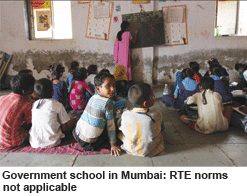The latest Annual School Census 2012-13 report of the Delhi-based National University of Educational Planning & Adminis-tration (NUEPA) for Maharashtra indicates that 93 percent schools in the state are deficient of infrastructure mandated by s.19 and Schedule of the Right to Free and Compulsory Education (RTE) Act, 2009. Only 7,355 of 103,625 schools fulfil all ten infrastructure norms stipulated by the RTE Act.
For the past 18 years, NUEPA has been releasing hard data relating to primary education. This year for the first time, the university has presented U-DISE (Unified District Information System for Education) which covers primary, secondary and higher secondary schools — an invaluable service.
Educationists and captains of industry in Maharashtra are dismayed — or should be dismayed — that India’s second most populous and industrial state (pop. 112 million), which contributes 14.4 percent of the country’s GDP, provides such poor school infrastructure. The norms prescribed by the Schedule of the RTE Act — teacher-pupil ratio, all-weather building, safe drinking water, separate toilets for boys and girls, kitchen for mid-day meals, playground, library etc — are embarrassingly modest by OECD nation standards. That even so, the overwhelming majority of primary-secondary schools are non-compliant with Schedule norms has caused the scams-tainted Congress-NCP government which has ruled the state since 2004, considerable discomfiture.
 “Maharashtra has met targets in terms of providing drinking water, separate toilets for boys and girls, providing textbooks, on which para-meters we have fared better than all other states. But given our size and population and since we have over 100,000 schools in the state, full RTE compliance will take some time,’’ says Siddhesh Wadkar, consultant for education policy and planning of the state government.
“Maharashtra has met targets in terms of providing drinking water, separate toilets for boys and girls, providing textbooks, on which para-meters we have fared better than all other states. But given our size and population and since we have over 100,000 schools in the state, full RTE compliance will take some time,’’ says Siddhesh Wadkar, consultant for education policy and planning of the state government.
According to Wadkar, Maharashtra’s steady progress in school education is testified by the state’s improved ranking in NUEPA’s Educational Development Index (EDI) 2011-12. “In 2009-10, Maharashtra was ranked #17. In 2011-12, we are ranked #8,’’ he says.
However, according to a Mumbai-based school principal, Maharashtra’s improved EDI ranking is not proof of improved learning outcomes in school education. “It’s indicative of how poorly other states are faring in their progress towards attaining the objectives of the RTE Act and in improving teaching-learning standards. Moreover, it’s important to note that the infrastructure deficiencies highlighted by the U-DISE report are mainly in government, not private, schools which are the saving grace.’’
This analysis is supported by U-DISE data. Of the 103,625 class I-XII schools in Maharashtra, 67,718 are managed by state and local governments. Another 21,259 are quasi-government (private aided). The total number of private independent (unaided) schools aggregate 13,989, of whom a mere 7,833 are English-medium institutions. “You can bet your boots that 95 percent of private English-medium schools are RTE-compliant,’’ adds the anonymous principal.
With government and aided schools comprising 80 percent of the total number of schools in the state, it’s patently obvious the majority of them are not RTE-compliant. But one of the major criticisms of the RTE Act is that while it prescribes punitive measures, including closure of private schools which don’t meet the infrastructure norms prescribed by the Schedule, government schools are exempt. Consequently, there is no pressure on state officials or government school principals to urgently improve infrastructure or learning outcomes.
In this context, Farida Lambay, former principal of the Nirmala Niketan College of Social Work and co-founder of Pratham — India’s most respected education NGO — is mildly critical of U-DISE’s focus on infrastructure provision and development. “While infrastructure is important, we also need to move ahead and focus on issues of quality of education, inclusion and community participation. It’s equally important to measure learning attainments to ensure that students are able to demonstrate effective learning outcomes in higher secondary education,’’ says Lambay.
But with state government education officials unable to follow simple infrastructure installation directives, asking for implementation of intangible teaching-learning and learning outcomes measurement norms is to ask for the moon.
Sunayana Nair (Mumbai)























